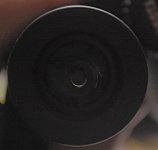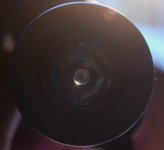"This doesn't detract much for me though with the M7, it's the 'looking-through-a-smokescreen' thing that crops up when looking for birds in densely packed denuded vegetation that has me handing the M7 to my wife and going back to the CL-P to see exactly what's going on in that hedgerow."It's not so much it didn't fit my face as the eyepiece cups only extending a tiny distance from the lenses. The eyepiece cups on the CL-P on the other hand extend way further out. I actually really liked the CL Companion in every other regard and would own it as my main binocular right now were it not for the issues I described. I actually emailed Swarovski asking about the availability of 'extended' eyepieces who - credit to them - responded within the hour stating no such eyepieces were available but that they were aware of the desirability of investigating the eye placement issue (they may just have been being nice to me - or they may have had other feedback). It also still suffered glare/flare notwithstanding the too-close-to-the-instrument 'diamond necklace' effect.
I don't mean to be too harsh on the M7 regarding colour fringing, it is, as I've written elsewhere, very well controlled. I suppose the very generous field of view is part of the reason as there is simply more 'image' to control and in high contrast situations I do sometimes pick up CA towards the periphery. I've seen blue, but also a turquoise on one side, and magenta on others side of the same branch in bare trees against a grey sky. When quickly switching to either Swarovski the worst I could induce was a tiny hint of purple-ish fringe towards the very extremity of periphery. This doesn't detract much for me though with the M7, it's the 'looking-through-a-smokescreen' thing that crops up when looking for birds in densely packed denuded vegetation that has me handing the M7 to my wife and going back to the CL-P to see exactly what's going on in that hedgerow.
Once again, with the personal preference caveat uppermost, when it comes to optical performance in the field in a variety of habitat and lighting situations, the CL-P is - for me - the most reliable for being able to accurately identify wildlife very quickly.
It just works really well (in daylight) all the time: the others don't.
I am trying to understand this "smokescreen problem". It almost sounds like a contrast or DOF issue. I haven't been able to replicate it but I will look for it. Maybe we don't have enough denuded vegetation in Colorado. Interesting point though.
Last edited:







